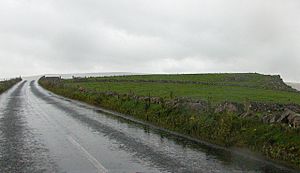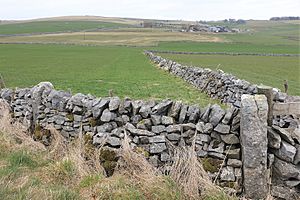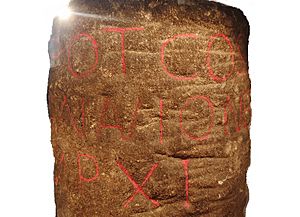Batham Gate facts for kids
Batham Gate is the old name for an ancient Roman road in Derbyshire, England. This important road connected the Roman fort of Templebrough in South Yorkshire to Brough-on-Noe (which the Romans called Navio) and the spa town of Buxton (known as Aquae Arnemetiae) in Derbyshire. The word Gate in this name means "road" in old northern English, so Batham Gate simply means "road to the bath town" (referring to Buxton, a spa town known for its baths).
Contents
What Was Batham Gate?
Batham Gate was a vital link in the Roman road network. It helped the Romans move soldiers, goods, and messages across the landscape. Imagine how hard it would have been to travel without proper roads! The Romans were excellent engineers, and their roads were built to last.
Finding the Roman Road
The exact path of the Roman road from Templebrough to Navio has been a mystery for a long time. Historians and archaeologists have been trying to find its precise route for many years.
Different Ideas for the Route
One early idea was that the Roman road followed a path called the Long Causeway near Redmires Reservoirs. This route even appeared on old maps. However, we now know that the Long Causeway was actually a medieval "saltway." This was a path used in the Middle Ages to transport salt, which was a very important product back then.
Later, a Roman road expert named Ivan Donald Margary suggested a slightly different route. He believed that after Redmires Reservoir, the Roman road didn't follow the medieval path. Instead, he thought it stayed on the line of the current track to Stanedge Lodge. From there, it went down Stanage Edge on a narrower, steeper path.
New Discoveries
More recently, in 2016, new excavations (digging in the ground to find old things) offered another possible route. This new evidence suggests the road might have passed close to a Roman villa (a large Roman country house) at Whirlow Hall Farm. Researchers from the University of Sheffield found a large feature in the Sheephill Road area of Ringinglow. This feature was about 20 meters wide and filled with rubble, with a hard, metalled surface. This discovery strongly suggests it was part of the lost Roman road.
Parts of the Road Today
Some parts of Batham Gate Road are still visible today. A section east of Peak Forest is even a protected Scheduled Monument. This means it's an important historical site that is legally protected from damage.
You can also find modern roads called Batham Gate Road in places like Peak Dale (near Buxton) and Bradwell (near Brough). These modern roads are remnants of the original Roman route. For example, the section crossing Bradwell Moor is now known as Clement Lane.
The Roman Milestone
In 1862, an exciting discovery was made in Buxton: a Roman milestone! This stone marker is the oldest inscribed milestone ever found in Derbyshire. Milestones were like ancient road signs, telling travelers how far they were from certain places.
What the Milestone Says
The inscription on the milestone is in Latin: ‘TRIB POT COS II P P A NAVIONE M P XI’. This translates to: "With the tribune's power, twice consul, father of this country. From Navio 11 miles."
This inscription tells us a few things:
- It mentions a Roman official with "tribune's power" and who was "twice consul." These were important political positions in ancient Rome.
- "Father of this country" was a title often given to Roman emperors.
- Most importantly, it tells us that this milestone was found 11 miles from Navio (Brough-on-Noe).
You can see this amazing piece of history on display at the Buxton Museum.
Images for kids







